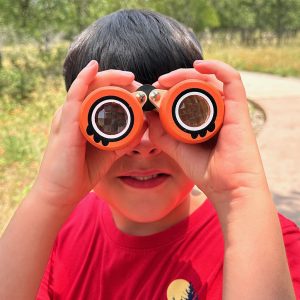For the past 25 years, the Hardwicke Interpretive Center has served as home to a diverse array of Texas wildlife, including a bobcat, skunk, beaver, prairie dog, and multiple birds of prey, turtles, snakes, and invertebrates. These animals, which we fondly refer to as our wildlife ambassadors, offer visitors the opportunity to observe some of the diverse wildlife found in North Central Texas. Each of these wildlife ambassadors has a unique story to tell. Some of them cannot be returned to the wild due to past injuries, and they serve as a reminder of the ongoing challenges they face today. Just last year, we welcomed our first representative from the family Testudinidae, a Texas tortoise, which has quickly become a beloved ambassador among school children and staff.
Texas tortoises, scientifically known as Gopherus berlandieri, are truly captivating reptiles. They are the smallest of the tortoise species found in North America, with a shell that serves as a personal fortress, measuring between eight and 10 inches in length. Their high dome shell, which comes in various shades, from yellowish-brown to dark brown, is adorned with yellowish-orange scutes, helping them blend into the dry, warm scrublands of South Texas and northeastern Mexico, their natural habitat. With sturdy, elephant-like feet, these tortoises navigate areas populated with prickly pear cacti, mesquite trees, and rocky terrain. Unlike some of their gopher relatives, Texas tortoises often prefer to take shelter under dense shrubs, cacti, or woodrat nests instead of creating extensive burrows. Maintaining a slow and steady pace through this unique Texas habitat, these tortoises can live up to sixty years according to current estimates.
Texas tortoises play a vital role in their ecosystem, thriving on a strictly herbivorous diet. They feast on an assortment of native vegetation in their arid habitats, primarily consuming prickly pear cacti, flowers, and various types of grass, all of which are integral to their survival. Their plant-based diet plays a crucial role in keeping them hydrated, especially during the dry seasons when water becomes scarce. Remarkably, these tortoises have adapted to be excellent cactus-munchers, consuming both the spines and the entire cacti. Additionally, they delight in the sweet, succulent fruit known as tuna, which becomes a seasonal treat and provides extra moisture and nourishment.
Conservation efforts are crucial for the survival of the Texas tortoise. Too many of these tortoises have been removed from their natural habitat, and habitat loss is just one of the human factors that has put their future at risk, making the Texas tortoise a protected species. It is illegal to capture, sell, or keep them as pets without special permits. This past year, the Texas Game Warden agency granted the Nature Center a permit to rehome an approximately 20-year-old male Texas tortoise. This new ambassador, whose home range is South Texas, is helping visitors and school-age children gain a deeper appreciation for these gentle reptiles. More importantly, he inspires responsible environmental stewardship toward our land and the amazing wildlife that call it home, showing us that each of us can make a difference in preserving our natural world.
Welcome the slow but steady superstar, the Texas tortoise, as the latest ambassador at the visitor center! On your next visit to the Nature Center, look for this relaxed, cactus-eating champion, whose exhibit is right next to the Eastern Screech-Owl. This small tortoise from Texas exemplifies adaptability and resilience, underscoring the importance of protecting the habitats of our native wildlife.



